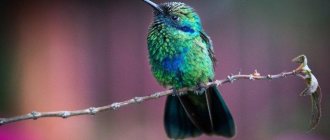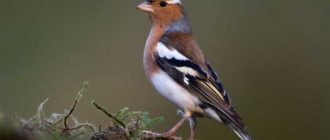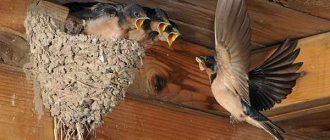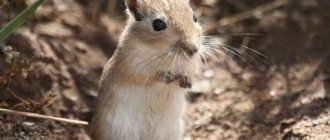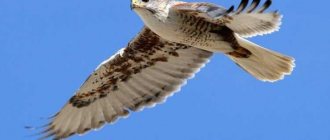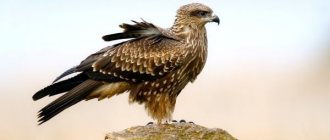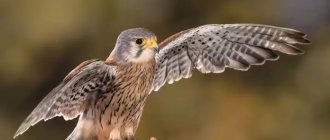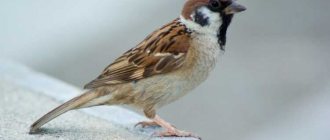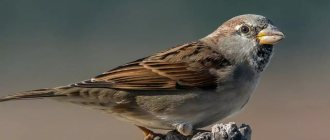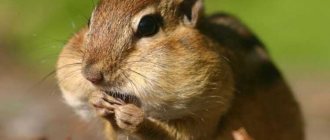Review author: “ZooVita”
Hummingbirds are the smallest birds in the world, but they belong to one of the largest groups of birds - the Trochilidae family. These fascinating birds live in deserts, mountains and plains, but most of them live in tropical forests. Their name refers to the buzzing sound made by their tiny beating wings.
Each species makes a different buzzing sound depending on the speed of its wing beats.
In the Caribbean, the hummingbird is called el zunzun. These energy dynamos have been around for many years. Hummingbird fossils found in Germany are believed to be over 30 million years old.
General description of the hummingbird bird
- Lifespan: 6 to 12 years
- Number of eggs laid: usually 2 sometimes 1
- Egg size: from 8 x 11 millimeters to 12 x 20 millimeters
- Incubation period: 14 to 23 days
- Maturity: 2 months to 1 year
- Size Length: the largest is the giant hummingbird Patagona gigas, 22 centimeters; the smallest is the bee hummingbird Mellisuga helenae, 5 centimeters
- Weight: from 1.6 to 23 grams
There are 328 species of hummingbirds. The smallest size hummingbird is the bee species from Cuba, and the largest is the giant hummingbird from South America. Hummingbird beaks also come in different sizes and shapes. The long thin beak is adapted for collecting nectar from flowers.
The beak protects a long forked tongue and allows each species of hummingbird to feed on specific types of flowers.
Hummingbirds are called nectarians because about 90 percent of their diet comes from flower nectar. They also snack on insects, which are often caught by hawks. Hummingbirds fly and dive to snatch insects from the air.
Hummingbird species
There are over 300 species of hummingbirds, ranging from the tiniest to the larger. The weight of the smallest inhabitant of Cuba is up to 1.6 g. The only hummingbird that once flew into Russian territory, according to official data, is the buff hummingbird.
Gigantic hummingbird
The largest representative of his family, and at the same time one of the most faded. The weight of an adult bird reaches 20 g, and the length is up to 15 cm. The color is brown-green with red and yellow splashes.
Photo: ru.sciencedc.com
Swordbeak Hummingbird
The amazing shape of the beak of this species is lost against the background of its length. It is up to 11 cm, despite the fact that the length of the entire body with tail is up to 9 cm. Sword-beak hummingbirds boast iridescent emerald plumage.
Photo: ianimal.ru
hummingbird bee
The tiny hummingbird weighs only up to 2g, which really makes it look like a big bee. Interestingly, the males of this species are smaller than the females. The color is gray-blue-green, but by the mating season rainbow and red tints appear.
Photo: kot-pes.com
Buffy Hummingbird
The same species that can occasionally be found in Russia. The bird has a wide tail, short wings, and its reddish-brown coloring is a bit like a sparrow's.
Photo: wallhere.com
Topaz Hummingbird
Quite a large species weighing up to 10 g with a very variegated multi-colored color. Orange, gold, green, purple, all with a distinctive metallic sheen.
Photo: nonograms.ru
Ruby hummingbird
A very common species in South America, and one of the most numerous in general. Females are brown and white and males are green, but all have a red chest patch and a tan breast.
Photo: pinterest.ru
Crowned Hummingbird
This species is easily identified by its small, thick beak. The color of the plumage ranges from light lemon to dark green and chestnut. This allows the bird to practically blend into the foliage.
Photo: clasbio.ru
Rook (60 photos): description of the bird, what it eats and where it lives
Appearance and color of the hummingbird bird
Hummingbirds come in a variety of colors and palette combinations, and some of their feathers change color as they move in the light. In the photo, the hummingbird shimmers with all the colors of the rainbow, which gave rise to names such as green-crowned comet, sapphire nozzle and ruby throat, which describe the beautiful, intricate feathers of these birds of paradise.
Most species of hummingbirds are shades of blue and green, with the male being much brighter than the female; after all, she must blend in with her nest while she incubates the eggs.
In the mid-1800s, hundreds of thousands of hummingbirds were killed for their feathers, and some species nearly went extinct. Luckily, people today realize that feathers look much better on birds!
Hummingbird Protection System
If a hummingbird sees a hawk or other bird in its territory that is an uninvited guest, it issues a sharp warning and begins to attack by diving.
Other hummingbirds and even birds of different species will often join in to dive bomb the intruder until it gets away. Hummingbirds are fearless because they can outwit everyone if they are not caught off guard.
Ecology DIRECTORY
| Orchid flower pollinated by hummingbird |
Voshiziaceae are pollinated by insects and hummingbirds.
The fruits are distributed by wind and water. [...] Pollinators of flowering plants are also warm-blooded, including hummingbirds, bats and even small rodents and marsupials (photo 13), however, without a doubt, the most important pollinators are insects (Grant, 1963). [...]
There are also two species of larkspur that grow in North America and are pollinated by hummingbirds. Larkspur, cardinal larkspur (Dolphinium cardinale, Fig. 104)) has bright red flowers arranged horizontally on thick stalks. The stamens and carpels are located below the entrance to the single horizontal nshore. In this species, flower specialization that promotes cross-pollination is combined with protandry. The lower flowers in the inflorescence ripen faster than the upper ones.[...]
At specialized corn processing plants, corn seeds are calibrated, treated, and in this form they are supplied for sowing in areas of the Non-Black Earth Zone.[...]
Flowering: Usually occurs in summer. It is curious that in nature, cactus flowers are pollinated by hummingbirds. Soil: good drainage is necessary. [...]
The pollinators of flowers in Norichinaceae are insects, and in the tropics and subtropics of America, also hummingbirds. Mullein and speedwell flowers, which have wide-open, short-tube flowers, have no specialized pollinators and are pollinated by a variety of insects. Long-tubular flowers are usually adapted to a very limited number of pollinators, often one or a few species of bees or bumblebees. These are the mask-shaped closed corollas of the toadflax and snapdragon species. In many species of lipstick, also pollinated by large Hymenoptera, the corolla is closed by a convex upper lip, but the purple lipstick (M. carcinoma), pollinated by hummingbirds, has wide-open flowers. The bubble-like swollen lower lip of the calceolaria, like that of the orchid - Lady's slipper, serves as a trapping pit for insects. The latter, getting into it, can get out only after coming into contact first with the stigma, and then with the spinules. Some species of mytaria with a very long corolla tube (see Fig. 222) are pollinated by long-proboscis butterflies. In the common and collinsia, the stamens and stamens occupy a lower position in the flower, and insects (mainly wasps) touch them with their back and abdomen.[...]
Watering: watering in winter is reduced but not stopped completely Flowering: flowers appear in summer and are pollinated by hummingbirds Soil: the soil should not dry out, good drainage is necessary." Reproduction: mainly by seeds. [...]
In the species Aplielanclra, Jacobinia and Sanchezia from the forests of tropical America, hummingbirds participate in pollination. The bizarre flowers of Louleridium donnoll-smithii, a shrub from Central America, with a sac-like swollen tube, are visited and apparently pollinated by bats.[...]
Many species of Sishochaidae with a relatively wide corolla tube (for example, Cantois species) are pollinated primarily by hummingbirds. Many genera have species pollinated by different pollinators. For the brilliant gilia (G. splendens), 4 races are noted, differing in the size of the corolla and the width of its tube. Two of them are pollinated by different groups of long-proboscis flies; the third, the most large-flowered, is pollinated by hummingbirds, and the fourth, small-flowered and living in the most arid habitats, is amo-pollinated. In many other genera, the stamens and style with stigma are shifted upward, so that pollinating insects carry pollen on the upper part of the body, and hummingbirds carry pollen on their heads. Numerous species of phlox with a long and narrow corolla tube are pollinated by long-proboscis butterflies, less commonly by hymenoptera and flies.[...]
Bright red fuchsia flowers, collected in hanging clusters, do not attract bees, which do not distinguish red well; they are pollinated by small birds - hummingbirds. This is facilitated by a sticky and viscous glue - viscin, secreted by fuchsia pollen. This glue stretches into long threads, connecting several specks of dust together. Such a thread with dust particles will stick to the long beak of a hummingbird and fly with it to another flower.[...]
Hummingbird species that carry pollen on the coccyxes of their beaks feed on the flowers of American long-tube Arizona honeysuckle (L. arizonica), ciliated honeysuckle (L. ciliosa), and honeysuckle (L. involucrata). The arrival of these birds in some areas coincides with the flowering time of honeysuckles and other ornithophid plants. [...]
The swollen base of the anthers carries a drop of nectar, which is secreted at the top of the stamen filaments. When a hummingbird sticks its beak inside a flower, the beak strikes the swollen base of the anthers, and immediately a stream of pollen sprays out of the tiny apical pores and lands on the small feathers at the base of the beak. When visiting other flowers, the feathers of the hummingbird's head with adhering pollen touch the protruding stigma. When pressing on the elastic wall of the anther with a match, a stream of pollen can be thrown out to a distance of 3 cm. Obviously, other species of this genus are also ornithophilous. The flowers of Bentham's brachiotum (B. benthamtum), endemic to Ecuador and Peru, are adapted to pollination by bees and bumblebees. Self-pollination has been observed in a number of species.[...]
Their pollinators are insects (bees and lepidoptera predominate among them), and for fuchsias mainly: hummingbirds. In the genus Ludwisha (75 species living in both hemispheres, mainly in subtropical and tropical regions), the number of sepals is from 3 to 7, the calyx does not fall after flowering. Their petals are yellow or white, the same as the sepals, or absent. The corolla tube is not continued above the ovary, the style is short, with a capitate or hemispherical stigma, surrounded at the base by nectar glands. According to American researchers J. Geitonogamy (transfer of pollen from other flowers of the same plant) is more typical for this species. The main pollinators are Hymenoptera. Based on their behavior in the :11 branch, they are divided into three groups. The first group includes insects that land on the stigma to collect pollen and nectar. These are the largest bee insects. The second group includes insects (mainly halicoids - NaPs1l [...]
The large, pendulous, powerfully fragrant, night-blooming flowers of the African species Rotlimannia and Gardenia are adapted to pollination by bats. Species of Coprosma and Anthospermum are obviously wind-pollinated plants. [...]
They are mostly annual herbs, occasionally perennial herbaceous plants, but shrubs are also found. Flowers with a large tubular, funnel-shaped or bell-shaped corolla. Hummingbirds help pollinate tobacco in America. The fruit is an ovoid, 2-4-leaf capsule filled with numerous small reticulated punctate seeds. Plants with a strong unpleasant odor. Many species of the genus contain nicotine and other toxic alkaloids. In all countries where wild tobacco grows, cases of poisoning of domestic animals by their leaves and young shoots have been repeatedly observed. [...]
Their pollinators can be not only insects (mainly bees and butterflies), but also birds (hummingbirds in South America) and bats. Adaptations for more reliable cross-pollination in Bignoniaceae have not yet been sufficiently studied. The most well-known pollination mechanism is in Incarvilleas, which have downwardly directed spur-shaped appendages on almost horizontally located anther nests (see Fig. 224).[...]
Monophages are organisms that feed on only one type of food. Thus, grape phylloxera feeds only on the sap of the grapevine; the caterpillar of the oleander hawkmoth feeds exclusively on the leaves of oleander and others. Monophagous birds include sunbirds (hummingbirds, bats), which have amazing adaptations for sucking nectar (tweezer-shaped beak with a strongly elongated tongue ending in a “tassel”), etc. [...]
Finally, coupled evolution is not limited to dietary interactions. Plant populations that include several different species may be grouped together because of their dependence on and shared evolutionary history with a single pollinator species—an insect or hummingbird (Baker 1963). It is easy to see how gradual reciprocal selection can drive evolution toward diversity, interdependence, and homeostasis at the community level.[...]
Watering in summer requires abundant watering, frequent spraying and regular fertilizing. In the winter months, the soil is moistened infrequently, but still trying to avoid drying out. Flowering: Cleistocactus flowers are brightly colored; their flower tube is very elongated; they are pollinated by hummingbirds. Under natural conditions, cleistocacti bloom almost all year round. Soil, cleistocactus grow well on a mixture of 2 parts turf soil and one part sand and gravel. Good drainage is necessary. Reproduction: by seeds and with the help of rooting shoots.[...]
Bird pollination (ornithophily) is especially characteristic of the tropics, but is also represented in the non-tropical regions of the southern hemisphere - in Australia, South Africa and South America. In the northern hemisphere, only in North America, visits to flowers by birds (several species of hummingbirds) have been established in areas far removed from the tropics, up to and including Alaska. [...]
Pollination is carried out by various representatives of the animal world - insects, birds (sunbirds, white-eyes, Australian-New Guinea honeyeaters and related South African sugarbirds and American hummingbirds), chiropterans (fruit bats and bats) and small flightless mammals (rodents, small marsupials from the family of climbing marsupials , or couscous - Phalangeridae).[...]
The process of pollination in the passionflower family is interesting. Large bright flowers, often with a strong scent and with a conspicuous crown of many different lengths of threads, ovaries and stamens raised on the gynophore, hidden nectaries - all of this indicates the presence of cross-pollination. Passion flowers are pollinated by various insects and hummingbirds. Miniature birds, without landing on a flower, plunge their beaks into the receptacle in flight to get sweet nectar and feast on small insects, also attracted there by the nectar. The insect trap is probably the inner crown, which covers the exit from the base of the flower with its thorns. Cross-pollination is facilitated by coordinated movements of stigmas and anthers. Immediately after the flower blooms, vertically located dust peaks burst into a longitudinal slit on the inside. Then they turn over, as if on hinges, first by 90°, coming to a horizontal position, and then around the axis and hang down with the open side out. Ripe pollen spills out and lands on the birds' bodies. Only after the anthers are free of pollen do the stigmas become receptive. Still sticking straight up, they begin to bend down and finally settle down in the same plane as the anthers. Thus, pollen from the bird’s body gets onto the ripe stigmas.[...]
The relationships between verbena flowers and their pollinators are varied but not well understood. Species of genera with a short corolla tube are usually pollinated by small Hymenoptera and flies, while those with a longer tube are pollinated by large Hymenoptera and butterflies. The most large-flowered species are pollinated by long-proboscis butterflies and birds (in America - hummingbirds, and in Asia, Africa and Australia - sunbirds and honeyeaters). Flowers pollinated by birds are odorless and usually have the red color of the hare, which is most attractive to birds. Recently, it has been found that the changing colors of lantana camara flowers are pollinated by very small insects - bladderworts or thrips. Thrips are constantly found only inside yellow flowers, which have fully developed stigmas. Thus, the change in color of flowers of this species indicates to pollinators at what time they should visit the flowers. [...]
Almost all olive plants are entomophilous plants. Collected in brightly colored inflorescences (yellow, red, white, lilac), the usually strong-smelling flowers secrete nectar at the base of the ovary and attract numerous nectar-sucking insects. Some menodora and jasmine flowers open in the evening and are pollinated by nocturnal insects; hummingbirds also take part in the pollination of jasmine flowers.[...]
Birds also take part in pollinating plants. Pollination of plants by birds, or ornithophily, is widespread in tropical and subtropical regions of the southern hemisphere. About 2,000 species of birds are known to pollinate flowers while searching for nectar or catching insects hiding in their corollas. Among them, the most famous are sunbird pollinators (Africa, Australia, South Asia) and hummingbirds (South America). The flowers of ornithophilous plants are large and brightly colored. The predominant color is bright red, most attractive to hummingbirds and other birds. Some ornithophilous flowers have special protective devices that prevent nectar from spilling out when the flower moves. [...]
Orpitophyllus flowers are so adapted to pollination by birds that they can no longer be pollinated by insects. Even Charles Darwin (1859) noted that the ornithophilous Mexican lobelia (L. splendens) growing in his garden was not visited by insects. Where the orpitophilous purple lobelia (L. cardinalis, table 63, fig. 242) with red flowers and the entomophilous syphilitic lobelia (L. syphilitica) with blue flowers grow nearby, hummingbirds pollinated only the first species, while the second pollinated exclusively insects. In this regard, we note an interesting case described by B.M. close to hummingbirds. However, this replacement of birds by insects is probably a very rare case. That the transition from ornithophily to entomophily is very difficult is proven by what happened in the Hawaiian Islands, where lobeliaceae are pollinated by flower girls. In those places where the flower plants became extinct, these plants, for example the short-haired cyanea (G. hirtella), switched to self-pollination out of necessity. [...]
The genus Bougainnella is widely known, including about 15 species, distributed in tropical and subtropical regions of South America. Bugeshshlleys are low trees or, more often, shrubs, creeping, climbing or clinging. A blanket of three purple, red, orange or white bracts encloses a group of three flowers, the pedicels of which are attached to the midrib of the bracts. Pollination is carried out by insects, sometimes probably also by hummingbirds. Some types of bougainvillea have good decorative qualities. They are readily bred in warm countries, where they form hedges and cover gazebos, the walls of houses and even roofs. Two Brazilian species are especially popular - naked bougainvillea (Bougain-viilea glabra, table 4.9) and wonderful bougainvillea (B. spoclabilis). Many garden varieties have been developed that are distinguished by their amazing beauty. The reader can see bougainvillea in the gardens of the Black Sea coast of the Caucasus and Crimea.[...]
By obtaining nectar and pollen, insects cross-pollinate flowers. The nectar of some tropical and subtropical plants also attracts birds. More than 2,000 species of plants from 50 families are known, which are pollinated by birds, which use different parts of the flower for food, mainly nectar. Among the birds that feed on nectar, the most famous are hummingbirds and flowerbirds in America and sunbirds, honeyeaters and white-eyes in the Old World.[...]
Cross-fertilization and seed dispersal carried out by animals are so effective that even imitative species have appeared among plants. It is known, for example, that spores of some fungi (Phallus, etc.) are released along with mucus, which has a characteristic putrefactive odor. This smell attracts flies, which then spread the spores attached to the legs. Research conducted in Arizona (USA) found that of the 9 species of flowering plants pollinated by hummingbirds and characterized by great similarity in color, size and shape of flowers, one species - Lobelia cardinalis, “taking advantage” of this similarity, attracts hummingbirds without producing nectar at all (J. Brown, A. Korfiic-Brown, 1979).[...]
Caperaceae are cross-pollinated plants, and in many cases protandry is observed. Pollination by bats has been established for some tropical capers (S. Vogel, 1958). The main pollinators are bees, attracted by the smell and abundance of pollen and nectar in flowers. However, the brightly colored flowers of many capers, such as capers acuminate (C. acuminata), glandular cleome (Gleome g-landulosa), species of Crataeva (Grataeva) and others, also attract small birds, in particular hummingbirds. The flowers of some species of the family open only at night and at the same time have a strong, pungent, often unpleasant odor for humans.[...]
Tropical rainforests of South America, equatorial Africa, southeast Asia. The amount of precipitation is more than 2400 mm/year, it rains almost every day. The climate is without a change of seasons, the average annual temperature is approximately 28° C. The largest ecosystem in terms of diversity of species and plant biomass. Forests with trees up to 60 m and higher (mahogany, wool, chocolate, wood, sandalwood). There are vines on the trunks and branches. The fauna is diverse: monkeys, snakes, lizards, flying squirrels, frogs, spiders, ants, parrots, hummingbirds, insects. Features - the soils are poor, most of the nutrients are contained in the biomass of surface-rooted vegetation.[...]
Six samples were made from each tested material, which were fixed on a special frame, permanently installed in the flow part of a horizontal oil trap, in such a way as to exclude the possibility of wastewater transferring corrosion products from one material to another. Samples were analyzed after 720, ¿160, 4320 hours of exposure. Two samples from each material were subjected to research: their mass was measured before and after exposure, and profilograms of the surface of the samples were constructed using a VEC Kolibr profilograph. The results of the experiments are given in table. 13.[ …]
Entomophilous plants (from the Greek - insects and love) - plants pollinated by insects. Thus, in the European flora of angiosperms, about 80% of species are pollinated by insects. This is one example of interspecific biotic factors that characterize the relationship between plants and animals. Entomophilous plants, unlike anemophilous (wind-pollinated) plants, have large, bright, fragrant flowers, and about 90% of species contain nectar. Birds (sunbirds, hummingbirds, bats, etc.) and insects (beetles, bees) play a huge role in the pollination of plants in humid tropical forests. In the Amazon basin there grows the “royal lily” (Victoria amazonica) with giant round leaves (up to 4 m in diameter), which is pollinated by a beetle (body length only about 3 cm). Many types of orchids are pollinated by bees (from the Euglossa family).[...]
It can be assumed that in a tropical rain forest, with evergreen foliage and plants that bloom throughout the year, there are still noticeable seasonal changes. Most tropical rainforest tree species have seasonal flowering and fruiting rhythms, and these rhythms vary widely among species. Some species are characterized by pulsating, profuse flowering at certain times of the year, while others bloom, although less profusely, over a long period. They are served by different pollinating animals. Some species of hummingbirds visit a wide area, searching for short-blooming species, while others follow more specific search routes along which they feed on any available flowers of light-blooming species. Some plants even have close adaptations to pollinators; among epiphytic orchid plants there are species, each of which is pollinated by a single species of bee with a seasonal rhythm of the life cycle corresponding to that of orchids. [...]
The initially five-membered calyx often becomes four-membered either due to the reduction of its upper lobe, or due to the fusion of 2 lower lobes. In the rattle (Rhi-nanthus), slightly swollen calyxes increase significantly in size after flowering, and in the Mexican rhodochoptope, very large bell-shaped red calyxes serve as an additional means of attracting pollinators - hummingbirds. [...]
The relationships between the inhabitants of tropical rainforests based on the type of food they eat are very complex. In Fig. Figure 70 shows a diagram of the relationship of trophic chains in the tropical rainforest ecosystem of South America. The shaded sectors represent the contribution of each type of nutrition to the creation of total animal biomass. The inner ring includes purely herbivorous forms of consumers of the first order, feeding both on dead parts of plants (1-4 - termites, beetles, bark beetles) and living plants (5-16 - two-toed sloth, parrots, howler monkey, butterflies , cicadas, tapir, etc.). The middle ring covers omnivores, i.e. consumers of the first and higher orders (17-24 - capuchin monkey, raccoon, hummingbirds, wasps, ants, mouse-like opossum). The outer ring contains carnivorous forms, i.e. consumers of the second and higher orders: 25-46 (mantis, iguana, anteater, woodpecker, boa constrictor, jaguar, armadillo, scorpion, etc.); This also includes animals living underground (ticks, cockroaches, dung beetles, earthworms). The royal vulture (44) and blood-sucking mosquitoes (46) - scavengers and parasites - are representatives of consumers of the highest order. Despite the endless variety of plant and animal species in the humid tropics, everything is quite orderly here, with each organism occupying its own ecological niche.[...]
Cacti differ from other succulents by the presence of special modified axillary buds - areoles (Latin areola - “platform”), which look like small pads. Like ordinary buds, flowers and fruits develop from the areoles of cacti. In not very specialized species of cacti, leaves appear from the areoles. In addition, the areoles give rise to hairs and spines. In some species of cacti, one areola can have up to a hundred or more spines. In many cacti, the areoles are pubescent, while in other species they are bare. In certain cacti (for example, mammillaria), at an early stage of growth, the areole is divided into two parts. One subsequently grows spines, and from the other, flowers and fruits. The areoles of cacti can also synthesize a sweetish liquid that attracts insects or birds hummingbirds.[...]
The first step toward understanding patterns of variation in the breadth of the feeding spectrum can be taken by considering the evolution of predators and their prey. The influence of the predator on the evolution of the prey can be seen in such properties of the prey as the unpleasant or poisonous leaves of many plants, the spines of hedgehogs or the protective coloring of many insects (photo 9); the influence of the prey on the predator is reflected in such properties of predators as a strong ovipositor in horntails, a multi-chambered stomach in cattle, silent flight and excellent sensory capabilities of owls. These examples of specialization clearly show that there are no predators that are capable of consuming all types of prey. Understandable restrictions prevent shrews from hunting owls (although shrews are carnivorous predators) and hummingbirds from feeding on seeds. Consequently, evolution often leads to dietary restriction.[...]
An insect crawling into the veechnik tube for nectar touches these appendages with its back and at the same time receives a portion of pollen that spills out of a crack that opens when it hits the appendage in each nest. When getting back, the insect touches the appendages of the opposite nests and again receives a portion of pollen from each speck. In the American genus Amphilophysmos (AtrkNorhyshn), the strongly thickened two-lipped corollas are always closed, which protects the abundantly secreted nectar and pollen from uninvited guests. Only large bees that pollinate flowers of this genus can open the throat of such corollas and gain access to the nectar. The very long and narrow corollas of the above-mentioned taiecium are visited by large butterflies from the hawk moth family. The flowers of species of this genus bloom in the evening and have a strong aroma. Bignopiaceae flowers, pollinated by hummingbirds and other small birds, are usually odorless and have red or purple corollas with an expanded, bare tube inside. Bats pollinate the flowers of many genera of the Crescentiaceae, including the "sweetroot" and "candle" trees. They are characterized by cauliflory, night flowering, usually white coloration of the corollas, a peculiar musky smell of flowers, and the secretion of a large amount of nectar.[...]
Tropical rainforests are common in the equatorial, tropical and subtropical zones of the Earth. They occupy an area of about 30 million square meters. km. They develop in conditions of excess moisture and heat. Distributed in South America, Africa, Southeast Asia, New Guinea and Oceania. Woody plant species predominate over herbaceous ones. The trees bloom, bear fruit and change leaves throughout the year. The tiers of the tree stand are practically not expressed, shrubs are most often absent, and the grass cover is poor. Flora and fauna are extremely rich. About 80% of all plant species grow here. The diverse animal population is concentrated mainly in the treetops. Mammals are characterized by monkeys, including anthropoids (chimpanzees, gorilla, orangutan, gibbons), large predators - leopard, tiger, jaguar. Birds include parrots, hummingbirds, toucans, etc. Lots of amphibians and reptiles. Invertebrates, primarily insects, are extremely diverse.[...]
The bright color of the petals, the presence of nectar and the characteristic smell of vanilla or honey attract numerous insects (bees, butterflies, flies) that pollinate the flowers of bindweed. To get nectar from the disk located at the base of the ovary, insects are forced to move apart the stamens and, at the same time, inevitably touch first the upward directed stigmas, and then the anthers located below. Among the insects that pollinate Convolvulaceae flowers, there are also those, such as, for example, the common carpenter bumblebee in the tropics, which obtain nectar not only from open flowers, but also hunt for nectar in the buds. Protection from this kind of “pollinators” are ants, attracted by the extrafloral nectaries located at the base of the flower. In America, the large funnel-shaped flowers of the bright red morning glory (Ipomoea coccinea) are pollinated by hummingbirds, and the fragrant, night-opening flowers of the white morning glory (I. alba), called the moon flower and widespread in the tropics of both hemispheres, by night moths (Manduca sexta) and bats .[…]
There are no consumers who live in isolation: they are all influenced by other consumers. The most obvious example is competition; many consumers face exploitative competition for limited food resources when consumer densities are high and food quantities are low; in this case, as the density of consumers increases, the rate of food consumption by each individual decreases. However, even if food supplies are not limited, the rate of food consumption per individual can decrease with increasing consumer density due to a number of interactions, which are generally called mutual interference. For example, many consumers interact with other individuals in a population on a behavioral basis; This leaves less time for food consumption and the rate of food consumption generally decreases. [...]
The competitive release of species in isolated habitats leads to a reverse niche shift, i.e., to the expansion of the realized niche towards the fundamental one in the absence of mainland competitors. The ecological literature is rich in examples of niche shifts in other types of habitats; these examples concern mainly animals. One of the striking examples of this type is presented in Fig. 3.8.[...]
Evergreen tropical rain forests (northern South America, Central America, western and central parts of equatorial Africa, Southeast Asia, coastal areas of northwestern Australia, islands of the Indian and Pacific Oceans). The climate does not change seasons due to its proximity to the equator, the average annual temperature is above 17 ° C (usually 28 ° C), the average annual precipitation exceeds 2000-2500 mm per year. Trees of different heights form a dense canopy of many tiers (up to 10-12 tiers are distinguished). There are no shrubs, the grass cover is poor. Epiphytic plants, whose roots do not reach the soil, and woody vines, which take root in the soil and climb the trees to their tops, develop on the trunks and branches of trees. The species diversity of plants is enormous. The fauna is richer in species composition than in all other biomes combined: mammals (monkeys, sloths, jaguars), birds (parrots, hummingbirds, toucans). There are numerous reptiles, amphibians, and brightly colored insects. Red-yellow ferrallitic soils are thin and poor in organic matter and mineral plant nutrients. Most of the nutrients are fixed in the biomass of vegetation. When tropical forests are cleared for arable land, soils lose fertility in 2-3 years.[...]
A very interesting representative of the Melicocceae tribe is the Spanish lime, or Melicoccus bijugatus, which lives in the tropical regions of America. This is a tall tree with pinnate leaves of 4, less often 2 or 6 leaflets (on the lower branches the leaves can be simple). The leaves are papery or almost leathery. Describing this plant, some botanists call it evergreen, others call it deciduous. In relation to the plant as a whole, its description as evergreen is correct: the melicoccus tree is not leafless. But melicoccuses completely renew their foliage every year. Leaf fall is especially spectacular during rainy times, in the spring, when the melicoccus grows new leaves and flowers within 48 hours. By the end of the second day, all the old foliage falls off in a still green state, covering the ground under the trees with a continuous carpet. Melicoccus flowers emit a very pleasant and strong smell. Spreading over a long distance, it attracts swarms of bees. In addition to bees, hummingbirds also flock to melicoccus, feeding on its nectar. However, the Latin name of the genus (from the Greek meli - honey and kok-kos - seed) is associated not with the honey-bearing plant, but with the extremely attractive sweet and sour taste of the melicoccus seed coat. [...]
The structure of the hummingbird bird
When it comes to flying, no one does it better. The best description of the hummingbird bird is its flight skills. Like a helicopter, the hummingbird can fly up, down, sideways, backwards and even upside down!
Most of its wings are composed of phalangeal bones, rather than breast bones like the wings of other birds. When soaring, the wings turn in opposite directions and then change direction in a figure eight pattern.
Hummingbirds also have muscles that allow for up and down motion, not just downward motion like other birds. They can flap their wings 20 to 200 times per second. Hummingbirds are so good at flying that most of them never walk.
Despite their tenacity, hummingbirds still face several smart predators. Hummingbirds have been caught by dragonflies, caught in spider webs, grabbed by frogs and stuck on thistles.
Perhaps the most amazing predator is the praying mantis. The insect sits motionless, camouflaged on a leaf or branch, and strikes with furious speed and force to grab it. Other birds, such as orioles and roadrunners, sometimes eat hummingbirds.
Thousands of New World plants rely on hummingbirds for pollination. Hummingbirds like bright flowers that open during the day when the birds are awake. They get most of their nectar from tubular inflorescences, the shape of which is ideal for their long, thin beak and tongue.
In some species, the bill is perfectly adapted to very specific nectar-bearing flowers, for example, the bill of the yellowtail sickletail matches the curve of Heliconia flowers.
Because they don't have a strong sense of smell, hummingbirds aren't attracted to scents, but they can easily see the color red, so they're often attracted to red flowers, which many nectar-loving insects don't see. Hummingbirds can hover over hanging flowers where bees and other insects cannot find a place to land.
The meaning of the hummingbird tattoo: from Indian mythology
But most often the hummingbird symbolizes love. And this is due to the fact that the Indians from Central American countries were sure that birds flying in pairs were the souls of lovers reunited after death.
Also, in some Indian tribes, the meaning of a hummingbird bird tattoo is a symbol of the fight against difficulties and the successful overcoming of any obstacles that arise along the way. This is due to the fact that in Indian mythology there are many legends in which small hummingbirds saved entire tribes from drought, hunger and other problems and difficulties, even fought for righteousness and helped find answers to the questions of the gods.
Hummingbirds help plants
When birds use their beaks to reach the nectar of a flower, the flower's pollen coats their head. When they jump to the next flower, they deposit pollen to help the flower reproduce. Hummingbirds are rainforest gardeners!
You might think that a hummingbird's day involves flying from flower to flower in search of nectar, but hummingbirds also bathe several times a day, splash in shallow water, sit near a waterfall or sprinkler and let the spray fall on them.
Some take advantage of the rain by sitting on a branch and spreading their wings and tail. Some even dive in and out of the water and then shake their feathers. After each bath, the hummingbird spends time arranging, oiling, and cleaning its feathers with its beak and talons.
In general, wild birds are not domestic birds, but hummingbirds are wild birds. Hummingbirds have a special diet that is difficult to replicate, so they will be difficult to feed properly and may become ill and die too early.
They prefer to live in a large area where they can use their specialized flight skills to find food that would be difficult for a domestic animal to provide.
They are also territorial and very assertive, bold little birds, and are unlikely to be the gentle companions that people expect from their pets. It's best to enjoy them for what they are.
The meaning of hummingbird tattoo for girls:
— lightness — tenderness — trembling — brightness
Read the article to the end: we deciphered each quality and selected sketches of hummingbird tattoos for girls and men. If you decide, then order a tattoo sketch and choose a tattoo artist in your city. I invite you on an amazing journey into the world of this magical bird.
Habitat of the hummingbird bird in the wild
You'll be surprised at the range of geographic locations where hummingbirds live. They live in a surprisingly diverse range of habitats. Some species live at high altitudes in the Andes, where they encounter frost and snowfall. On especially cold days, these birds take refuge in caves.
Other species are found in cool, dry grasslands, forested lowlands, tropical forests, and even desert areas. Many species of hummingbirds typically migrate 800 kilometers or more each year. The rufous hummingbird migrates a whopping 4,800 km from Mexico to Alaska, where it breeds in the summer.
Even though hummingbirds are small in size, they have a large appetite. Their diet mainly consists of liquid nectar and these birds practice a lot with it all in order to move from gulp to gulp. These small birds consume between 3.14 and 7.6 calories per day. At first glance this doesn't seem like much, compared to a human (who can eat 3,500 calories per day) with the metabolism of a hummingbird, he would need to consume approximately 155,000 calories per day.
This is 77 times what most people need! The hummingbird's high calorie requirement is due to its high heart rate and small body size. Some hummingbirds have been observed to visit 20 flowers per minute, and with their hover-and-sip feeding style, they continue to flap their wings and exercise even while eating.
Because they eat so much, hummingbirds must digest their food quickly. They can digest a fruit fly, soft insect or spider in 10 minutes. To survive the night without having to feed dozens of times, hummingbirds enter a kind of hibernation, lowering their body temperature and heart rate so they can get some rest.
Hummingbird species
The hummingbird family includes 340 species. Information about some of them is presented in the table below. Descriptions and photographs of species will help you write a report or thematic abstract.
Features of body structure
| Hummingbird | Body length, cm | Weight, g | Wingspan, cm | Speed, km/h | How long does he live, years | Mating period | Number of eggs laid |
| Bee | 5-6 | 1,6-2 | 3,3 | 48 | 7-10 | March-June | 2 |
| Ispolinsky (Giant) | 19-20 | 18-20 | 22 | 30 | 3-5 | April June | 2 |
| Kalypta Anna | 10-11 | 4- 4,5 | 11,4-12,1 | 35 | 8,5 | December-June | 2 |
| Tricolor Selasphorus | 8-9 | 3-4 | 13 | 40 | 8-12 | May-July | 2 |
hummingbird bee
The birds are native to the Cuban archipelago, including the main island, as well as Isla de la Juventud (West Indies).
Natural areas and places where they can be found:
- tropical rainforests and dry forests;
- edges of thickets of vines and bushes;
- mountain valleys;
- wetlands;
- gardening plantings.
The Bee Hummingbird is the smallest bird in the world. Compared to other members of the family, its body is rounded, smooth in outline.
The plumage of the male is green, with a bright red iridescent boa (feathers on the throat). The upper part of the body and elongated side feathers are blue, the lower part is grayish-white.
The female has a bluish-green upper body and a pale gray lower body. The tips of the tail feathers are white.
Birds lead a sedentary, solitary lifestyle. Short trips are made only to nearby islands. They carefully guard their habitat, aggressively driving away uninvited guests. Hummingbirds are active during the day. They feed mainly on nectar. Occasionally the diet is supplemented with insects and spiders.
In one day, the hummingbird bee visits at least 1,500 flowers.
They can fly in different directions - up, down, backwards and even upside down. They communicate using high-pitched creaking sounds. During feeding they make a loud chirping sound.
With the onset of the mating season, males change the color of the plumage on their head, throat and chin. It turns reddish or bright pink. To attract partners, males perform aerial pirouettes and emit short ringing trills.
Birds do not form stable pairs. Nest construction is the function of the female. Using pieces of cobwebs, bark, and lichen, she builds a cup-shaped tray with a diameter of about 2.5 cm. Its bottom is lined with down and soft plant fibers. The mother, without the participation of the male, incubates the laid eggs and raises the hatched chicks. They begin independent life 18-38 days after birth. Reproductive maturity is reached at the age of 1 year.
Gigantic (giant) hummingbird
Representatives of this hummingbird species are the largest in their family. They are comparable in size to European starlings.
The birds live at an altitude of 2000-4300 m above sea level in the Andes of South America. Distributed from southwestern Colombia to central Chile and Argentina.
Within their range, they are found in desert forests and shrubs.
There are no external differences between the female and the male.
- The color of the upper body is light brown with a green tint. Darker small spots and wavy stripes are noticeable against the main background.
- The abdomen and lower part of the wings are grayish-brown.
- The flight feathers of the wing are dark brown.
- The plumage of the uppertail is gray with a yellow tint.
- The tail is long, with a shallow fork.
Birds make a loud, sharp whistle.
The basis of the birds' diet is the nectar of brightly colored, fragrant small flowers of trees, herbs, and shrubs. Hummingbirds prefer plants with red tubular calyxes as they have the highest sugar content. They drink the sweet liquid while floating and raising their tails up. Sometimes they hang on a flower while feeding.
Small spiders and insects serve as a source of protein. Birds catch them in flight, collect them from leaves or extract them from cobwebs.
A nesting female can eat up to 2,000 insects per day.
Males create feeding territories that they protect from competing hummingbirds, as well as large insects - bumblebees, moths.
Birds lead a solitary lifestyle, with the exception of the breeding season. The male leaves the female after mating. He does not participate in choosing a location, building a nest, or raising chicks.
The female is responsible for creating the nest. It is a bowl with a diameter of 20 cm and a height of 15 cm. The bird weaves it from plant fibers, strengthens it with cobwebs and camouflages it on the outside with green moss. This structure gives the nest elasticity, allowing it to stretch as the chicks grow older.
The mother feeds the hatched chicks with regurgitated food. These are mainly partially digested insects, since there is not enough nectar for the rapidly growing offspring. The chicks fly and leave the nest when they are about 20 days old.
Kalipta Anna
This species of hummingbird is common on the west coast of North America.
Kalypta lives in:
- open forests;
- thickets of chaparral - evergreen shrubs;
- oak savannas;
- open meadows.
The species is well adapted to living in city parks and gardens.
The bird's plumage is bright:
- bronze-green back;
- pale gray body;
- light belly;
- green sides.
An adult male has an iridescent cap and crimson-red gorget, and a brownish-gray breast. The female also has iridescent red spots on her head, but usually smaller and not as shiny as the males.
Calyptas lead a solitary lifestyle. Active during the day, collecting nectar from flowers. The menu also includes small insects caught on the fly or collected from leaves. Vocal behavior of birds is not expressed. Males are more often heard: they cry out sharply and briefly, sitting on tree branches.
During the mating season, the male, courting his chosen one, sings and demonstrates flying abilities. Having risen to a height of 40 meters, it dives sharply down. At the lowest point of the movement it emits a scream, which observers describe as an “explosive squeak”.
After the mating, the couple separates. The female builds a nest in the branches of a bush or tree. This is a rounded structure made of plant fibers, down, feathers, and animal hair. Its outer side is disguised with pieces of lichen, dry grass, and sometimes city garbage - shavings, tissue paper.
The incubation period is 14-19 days. The chicks remain in the nest for 18-23 days. During this time, they gain enough strength to feed on their own.
Tricolor Selasphorus
In summer, the birds are found from Guatemala to Mexico, the western United States and Canada. In winter they migrate to southern Mexico and Guatemala.
Natural habitats:
- pine-juniper forests;
- oak forests;
- subalpine meadows;
- mountain valleys.
During the breeding season, Selasphorus moves to mixed forests with a predominance of spruce.
Adult birds have an iridescent green back, a white eye ring, and a rounded black tail protruding beyond the tips of the wings. The male has a characteristic bright pink-red throat color. Females have lighter plumage.
Representatives of the hummingbird species feed on flower nectar and small insects.
Birds communicate using several types of sounds.
- Sound signals - repeated sharp chirping.
- The rumble of the wing during flight. Its range is 35-100 Hz. The sound is produced by both the male and the female.
- The wing trills that the male makes during courtship. They are created when air passes through the 9th and 10th primary feathers of the wing. The trill can be heard at a distance of 50 meters. It attracts mates and scares away rivals.
Like other hummingbirds, Selasphorus do not form strong pairs. After successful courtship, the birds part. The female builds the nest alone. It takes 4-5 days. The bird attaches a cup-shaped flexible structure made of grass to a tree branch. Outside, the nest is reliably camouflaged with lichen, moss, and bark.
The clutch contains 2 white eggs with a diameter of 1.2-1.5 cm. The bird incubates them for 16–19 days. As the hatched chicks mature, the size of the nest increases. The offspring becomes completely independent after 10-12 days.
Family life of hummingbirds
A mother hummingbird sits on her nest. Hummingbird nests are made from a variety of materials, which may include moss, leaves, hair, feathers and fur, which are attached to branches using webbing.
Males use their bright colors to court females. It is believed that the brighter the male's feathers, the healthier he is. Defending the territory, the male tries to stand out as much as possible, flashing iridescent feathers on his neck, head, tail or back. Hummingbirds' eyes are sensitive to ultraviolet light, so colors can appear even brighter to them than human eyes.
These color signals only work at close range, so hummingbirds also produce short chirps and whistles. Some species have a complex musical whistle that attracts the attention of the female.
Males defending a territory produce what are called "chase calls," which are rapid-fire chatter unique to each species. If the offender does not leave, the two may fight, grabbing each other as they flee and falling to the ground.
Hummingbirds are not very social animals, so you will never see them flying in flocks. In fact, males and females live separately until the breeding season, when the male calls the female and shows her his beautiful feathers.
Some species of male hummingbirds attract a female by forming a lek that can include up to 100 males. If the female thinks that one of the males is interested, he may perform a flying dance in the air for her.
Small birds lay tiny eggs. After mating, the female must build a nest and raise the young on her own. The eggs of smaller hummingbirds are about the size of a coffee bean.
Hummingbird chicks hatch with their eyes closed. They only have a little fluff on their body. These tiny chicks are very vulnerable and sometimes their predators include large insects! Luckily their mothers are very caring. The chicks fledge after three to four weeks, and sometimes the mother has a second brood.
Hummingbird breeding
Hummingbirds are polygamous and breed very actively, with the southern species doing so throughout the year. The male aggressively defends his territory before mating, but then immediately flies off and leaves the female.
The female builds a small nest on leaves or branches. In size and appearance it resembles a walnut shell. There she lays several eggs and incubates them for 2-3 weeks, independently obtaining food and defending the territory. The female hummingbird bravely protects her offspring, piercing potential enemies with her beak.
The chicks need a huge amount of nectar, which the female carries continuously throughout the day. While the mother is away, they fall into suspended animation, and thus wait for her presence. After 3 weeks, the chicks can already leave the nest.
Photo: en.wikipedia.org
Environmental activities
The metallic or iridescent color of hummingbird feathers and the tiny size of the bird itself made them a target for collectors in the 19th century, with wealthy individuals often displaying a box of stuffed hummingbirds in their home. Fortunately, most species of hummingbirds have adapted to the presence of humans.
It is important to keep hummingbird habitats stocked with native plants to ensure the birds have food available. Gardens that contain flowers suitable for hummingbirds have helped find balance with humans in the habitat. However, in many parts of the world the human population is growing so quickly that hummingbirds are losing their habitat.
Helping Hummingbirds Pollinate
Birds that attract hummingbirds can easily assist the birds in their natural pollinating duties, resulting in more abundant blooms in the garden. To help hummingbirds pollinate:
- Hummingbird garden design with vertical layers and tiers for easy access to flowers.
- Plant a variety of flowers that attract hummingbirds to attract more birds.
- Avoid using insecticides or other chemicals that may repel hummingbirds.
- Whenever possible, choose native flowers and plants that are most familiar to birds.
- Set up hummingbird feeders in your garden. This can attract more birds to your yard, and more hummingbirds mean more opportunities for pollination.
Hummingbirds are effective pollinators. Understanding what flowers have done to encourage this help and how birds pollinate flowers can help birders better appreciate hummingbirds and meet their needs in the garden.
Promoted Video
Interesting facts about the hummingbird bird
- The green hummingbird with violet ears can fly short distances at speeds of up to 150 kilometers per hour.
- Hummingbirds are the only birds that can fly backwards.
- On average, a hummingbird eats half its body weight in the equivalent of sugar each day.
- The ruby-throated hummingbird has the smallest number of feathers ever thought to be on any bird.
- It is estimated that the average hummingbird needs to eat every 15 minutes.
- To conserve energy, a hummingbird's body temperature drops from 40.5 degrees Celsius to 18 degrees Celsius at night.
